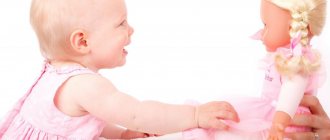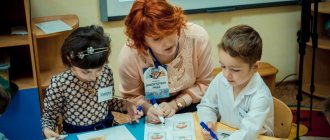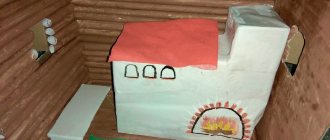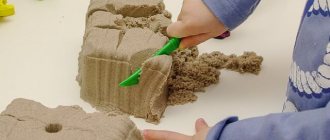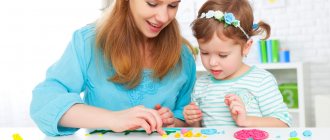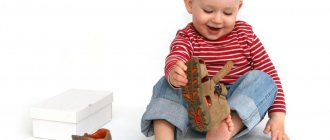Early Cognitive Development
By the beginning of early childhood, the child begins to perceive the properties of surrounding objects, grasp the simplest connections between objects and use these connections in his manipulations. This creates the prerequisites for further mental development, which occurs in connection with the mastery of objective activities (and later - gaming and drawing) and speech.
The basis of mental development at an early age is formed in the child by new types of perception and mental actions. (Mukhina, pp. 94-95)
In objective activity, perception develops. No development of objective actions is possible without orientation to individual features of the object.
As studies have shown, the accuracy of perception is great, but the perception itself is unique. It, firstly, fixes one quality of the object, and subsequently the child is guided by this quality when recognizing the object. Secondly, the perception of a young child is affectively colored and is closely related to practical activities. (Sechenov believed: “perception at an early age is passion”).
So, for example, if a child is shown a cactus, given the opportunity to touch it with his hand, and then asked to draw it, the child, as a rule, will draw it with greatly exaggerated spines. (Obukhova, S. 220)
An example of the first feature of perception of a young child may be such a feature of perception as recognition of close people in photographs and objects in drawings, incl. on contour images. This is due to the fact that children of the second year of life do not perceive drawings or photographs as images of objects and people. For them, the depicted objects are completely independent objects. And if a child names an object and its image the same, it means that he identifies them, perceives them as one and the same. Identification becomes possible because There is one detail in the image that most attracts the child’s attention. First of all, the child pays attention to shape and size. Color, although it distinguishes, does not give attention to it.
In order for perception to become complete and comprehensive, the child must develop new perception actions. Such actions develop in connection with the mastery of objective activities, especially correlative and instrumental actions.
When playing with a pyramid or matryoshka, a child performs many matching actions to assemble these toys. All this can be called external indicative actions that allow the child to achieve the correct practical result (assemble a pyramid).
Such toys are called autodidactic (self-learning).
External orienting actions develop in a child also when mastering instrumental actions. So, trying to reach a distant object with a stick, a child can take a short stick and, making sure that it is no good, replace it with a long one.
From correlating, comparing the properties of objects with the help of external indicative actions, the child moves on to visually correlating the properties of objects. A new type of perception action is formed (2.5 – 3 years). (Mukhina, pp. 96-97)
Along with visual perception, auditory perception also develops intensively at an early age. Phonemic hearing develops especially intensively and, as a rule, by the end of the second year of life, children already perceive all the sounds of their native language. (Petrovsky, 79, p. 45)
Perception is the leading mental function of early childhood. Thus, the memory of a young child always manifests itself only in active perception - recognition (this explains the fact of early childhood amnesia: almost no coherent memories are preserved, so little does it participate in the activity of consciousness).
Peculiarities of early age perception (in addition to those mentioned above):
1) its affective character, passion. Emotions are detected mainly at the moment of visual perception of the object to which they are directed. Adults learn to look at things, distracted from the immediate emotion they evoke, and without showing any interest at all in a number of things. For an early age this is impossible, because perception and emotion are fused into a single whole. As a result, this leads to another feature of perception:
2) perception is directly related to action and determines behavior; unity arises between sensory and motor functions. As a result of actions with objects, the child begins to perceive the properties of surrounding objects, grasp the simplest connections between objects and use this knowledge in his actions with them. This creates the prerequisites for further mental development, which occurs in connection with the mastery of objective activities (and later, elementary forms of play and drawing) and speech.
By the beginning of early childhood, the child masters visual actions, which make it possible to determine some properties of objects and regulate practical behavior. However, the accuracy and meaningfulness of such objective perception is very low, although at first glance this is not noticeable. In fact, a child of the 2nd year of life cannot accurately determine the properties of familiar objects - their shape, size, color, and the objects themselves are usually recognized not by the totality and combination of properties, but by individual, conspicuous signs (one of the features of perception) .
Children cannot consistently, systematically examine an object, identifying its different properties, so perception, as it were, “snatches” one conspicuous sign and “identifies” the object by it. This may be a small area of an object that the child encounters when manipulating. Thus, touching a toy bird with a sharp beak, the child learns the word “pti” and then calls this all objects that vaguely resemble a bird and have a protrusion (“beak”).
Throughout an early age, the child's perception becomes more accurate and meaningful as he masters new perceptual actions. Such actions collide in the mastery of objective activities, especially in the mastery of correlative and instrumental actions. First, children perform actions in the material plane, then move on to visual correlation. A new type of perception action is being formed. The property of one object turns into a sample, a standard with which it “measures” the properties of other objects. For example, the size of one ring of a pyramid becomes a measure for other rings. Gradually, the child begins to perform objective actions without preliminary trying on, but only with the help of visual orientation.
In connection with the development of visual correlation, a child aged 2.5 - 3 years old becomes able to make a visual choice based on a model (first by shape, then by size, and later by color). The models for identifying the properties of an object are the ideas that are fixed in memory about the properties of certain objects, known from one’s own experience. Therefore, when identifying round objects, the child says “like a ball” (there are no sensory standards yet). For ideas to appear, the child’s active actions with these objects are necessary.
A child of the 3rd year of life is able to master the concepts of 5-6 shapes (circle, oval, square, rectangle, triangle, polygon) and 8 primary colors, although he is still poorly able to name them.
Auditory perception
: phonemic hearing is especially developed (first, vowels are identified and recognized, and then consonants; by the age of 2, all sounds of the native language are differentiated).
Pitch develops slowly, so there is no point in teaching a small child to sing. By the 3rd year of life, children learn to perceive relatively small differences in pitch of sounds if this learning is introduced into a game, where, for example, a high voice belongs to a small animal, and a low voice to a large one.
Under the influence of perception, all other mental processes develop. Memory, for example, at this age is involuntary. Although during this period a memory appears, and moreover, the latent period of the memory increases, the child does not remember himself, but “he is remembered.” Memory does not yet act as a separate process.
Memory. The predominant types are motor, emotional and partially figurative. Manifestations of good memory (when long poems are recited by heart) do not mean that the child has a phenomenal memory or a high level of intelligence. This is the result of the general plasticity of the central nervous system, characteristic of all young children.
According to L.S. Vygotsky, all mental functions at this age develop “around perception, through perception and with the help of perception.” This also applies to the development of thinking. (Obukhova, S. 221)
Thinking. Appears on the threshold of early childhood and is manifested in the use of connections between objects to achieve some goal (for example, a child pulls a pillow on which an attractive object lies in order to get it). At first, establishing new connections is a matter of trial and error. Some children, having achieved a result, deliberately return the object back and either bring it closer or move it away.
Children solve most problems of this type through external orientation actions (EOAs). These actions differ from VOD perception, aimed at identifying and taking into account the external properties of objects.
Thinking based on WOD is called visual-effective (aimed at finding connections between objects and actions that make it possible to obtain a certain result).
But already at an early age, children begin to perform mental actions, performed without external tests, in their minds. The child transfers the method worked out in 1 situation to a similar situation. This is based on tests carried out in the mind, when the child acted not with real objects, but with their images, ideas about objects and ways of using them.
Thinking in which the solution of a problem is carried out through internal actions with images is called visual-figurative. While the child solves only a limited class of problems with its help, more difficult problems are either not solved at all or are translated into a visually effective plan.
One of the significant acquisitions is the sign-symbolic function of consciousness. Therefore, at an early age, the child begins to understand that some things and actions can be used to designate others and serve as their substitutes. However, the sign-symbolic function completes development in adulthood.
By the end of early childhood, mental activity develops, including: 1) the ability to generalize; 2) to transfer the acquired experience from the original conditions and situations to new ones; 3) the ability to establish connections between phenomena and objects through experimentation; 4) remember these skills and use them when solving problems. (Nemov, P. 76)
The basis for generalizations is created by the assimilation of speech, since the meanings of words always contain generalizations. (For example, a child is taught to refer to the word “clock” as a small hand clock, an alarm clock, a large wall clock, etc.). (Mukhina, P. 100)
Mastering speech, which contains generalized words (signs of objects), is associated with the child’s transition from visual-effective thinking to the formation and functioning of visual-figurative thinking, because an image represents some abstraction of the properties of an object. In an image, a sign (word) is associated with meaning, but is already separated from the direct perception of the object it denotes.
Chronologically, the beginning of the formation of visual-figurative thinking in children is confined to the end of early childhood and usually coincides in time with two events: 1) the formation of elementary self-awareness; 2) the beginning of the development of the ability for voluntary self-regulation. All this is accompanied by a fairly developed imagination of the child, which is reproductive at an early age. First, when the child is at the stage of visual-effective thinking, he has the opportunity to explore the world around him, solve problems by observing it and performing real actions with objects in his field of vision. Then images of these objects appear, and the ability to operate with them arises. Finally, the image of an object can be evoked and maintained in the child’s mind not only by external object signals, but also by the spoken word. This is visual-figurative thinking. (Nemov, S 76-77).
MAGAZINE Preschooler.RF
Formation of cognitive interest in children of early preschool age using experimental activities.The process of cognition of a small person differs from the process of cognition of an adult. Adults understand the world with their minds, small children with their emotions. The cognitive activity of a 2-3 year old child is expressed, first of all, in the development of perception and meaningful objective activity.
Cognitive development is a continuous process. It begins immediately after birth and ends with the last breath. Every second a person receives some new information, compares it with what is already known, analyzes it, and remembers it.
The mental and mental development of a child is impossible without cognitive activity. Each age has its own capabilities, as well as individual needs for learning about the world. Everything that a baby gets acquainted with at this stage of life plays an important role for him in the future. The new information received is transformed into knowledge and, therefore, into experience.
There are two important components to consider in a child’s cognitive development.
Firstly, the actual information that the child receives from the outside world. Secondly, the child’s attitude towards the information he receives. In the first case, to improve the child’s cognitive development, it is important to analyze the following:
a) what kind of information does the child receive: does it meet his cognitive needs? Is it completely new, or does it coincide with what the child already knows, or does it change existing knowledge?
b) how exactly does the child receive information: in the process of his own activities or from the words of others? Who or what is an authoritative source of information for a child?
c) how does a child know how to handle information? Depending on his age and level of development, relevance and clarity of information, a child can remember it or forget it, systematize it or analyze it...
The cognitive development of a child can be divided into two stages: obtaining new information and forming the child’s personal attitude towards it.
Each new skill gives the child the opportunity for new discoveries, and the older the young researcher, the more intense the development of cognitive abilities. If up to two years of age the cognitive process mostly occurs through movement, then later vision begins to predominate: the child learns to look at objects, gradually incorporating other methods of perception (smell, hearing, touch). By the age of five, a child has accumulated quite a large amount of knowledge. Speech acquisition plays an important role in a child’s cognitive activity. The larger the baby’s vocabulary, the more new information he is able to accept and understand. You can stimulate the development of cognitive activity through games and exciting activities. A child can learn new things everywhere: on a walk, on public transport, in a clinic. The main thing is that adults can competently talk about something new and have the imagination to come up with an interesting task for the child. For example, on the way to kindergarten you can tell what you saw. Ask your child: “What kind of transport do you see?” , “Count how many cars are white” , “What is white in nature?” .
When reading books, it is very important to talk about what the child heard and ask questions about the illustrations. The older the child, the more difficult the questions and tasks he can handle, and the more complex topics interest him.
In solving problems of sensory development, a significant role is played by the selection of toys and aids of different colors, shapes, and materials. You should select objects that are contrasting in one of the characteristics, but similar in others (for example, balls, cubes of the same color, but different in size). The variety of objects and their properties attracts children’s attention, and the emphasized differences and similarities of features deepen and clarify perception.
If in early infancy, the baby is characterized by unbridled curiosity and “responds” mainly to external effects, such as brightness of color, unusual shape, novelty of details, “originality and power of sound,” then in the 3rd year the child is captivated by the “hidden” properties of objects. It is important to note that “hidden” properties through targeted exploratory actions: stroking, tapping, applying to the ear, etc. The baby, as it were “studies” the object, discovering its properties “hidden” in its design, and the more “surprises” the research activity presents to him, the more interesting the situation itself is for him. The desire to explore also creates such a wonderful quality as curiosity. a “discoverer” in a child . He wants to experience everything himself (what will happen?), be surprised by the unknown, learn something new in the familiar. This is how experimentation begins. Search situations lead children to experimentation, i.e. that activity that allows the child to model in his mind a picture of the world based on his own experience and observations. It is necessary to make curiosity a manageable process. With the help of games with elements of experimentation it is possible to:
- Continue to instill in the child a cognitive interest in the world around him. Develop his curiosity, understanding of the simplest cause-and-effect relationships in the “action-result” .
- To foster the child’s cognitive activity, the desire to learn new things, observe, remember, compare, and experiment. Transfer the actions of playful experimentation into a useful direction, developing a caring attitude towards the environment.
- To cultivate aesthetic feelings, the desire to protect and create beauty.
- To practically acquaint the child with some phenomena of living and inanimate nature, to form ideas about some properties of objects, things, relations of the objective world (volume, mass, movement, speed, time, hollow, through, closed space, etc.).
- Teach your child to express his impressions in words.
- Enrich the child’s impressions with works of poetry and folklore.
"Colorful balls"
Goal: Use a game situation to familiarize the baby with such properties of water as the possibility of coloring it (takes on the color of paint, for example, when painting with a brush).
Material: Gouache and special cups filled 1/3 with clear water; white paper, balloon stencil in the form of a bag with a slot for colored inserts / I8x15cm/.
An adult draws attention to the fact that he has several paints, for example, red, green, blue, yellow, and on his sheet of white paper he “tests” each paint, names the color, tries to arouse keen interest in the child, rinses the brush in a glass of water . The leaf becomes colorful. The child remembers the names of each paint. Then the child acts independently under the guidance of an adult. First, the child is invited to work, for example, with red paint. A child applies red paint to a white sheet, an adult demonstrates the technique of blurring the paint. The child paints over the entire piece of paper. His attention is drawn to the fact that the water in the glass has turned red, especially after the brush has been washed. The red leaf is set aside to dry. A jar of colored water is placed nearby. Familiarization with other paints is carried out in the same way. After all the leaves have dried, they can be placed in a bag on which an image of a balloon (stencil) with a dark thread is cut out. The adult takes out the leaves one by one, and the “balls” change their color: “What color is the ball?” , “What is this one?” etc.
"Magic colors"
Purpose: To show how mixing three primary colors produces others. So, for example, combining yellow and blue gives green, red and yellow - orange; red and blue - Violet (lilac); red and black - brown, etc. Materials: Gouache, brushes, 4-5 empty transparent glasses.
The child chooses the color of paint with which he wants to paint; washes the brush in a glass, thus creating colored water. “Then the child paints with a different paint and rinses the brush in another glass, and water of a different color appears in the second glass. The child paints with all the colors one by one, rinsing the brush in a new cup each time. If the child repeatedly uses any paint, he washes the brush in a cup of the appropriate color. The adult collects all the glasses on one tray and invites the child to show a “trick ,” pours, say, red water into a clean glass and adds yellow water. “What have we done? What color is the water? - Orange. This color can be the sun, orange, tangerine, flowers . Similarly, an adult gets purple, green, brown, etc. Note. Three colors are considered basic: red, yellow, blue. It is when they are combined that all other colors of the spectrum are obtained. Shades (blue, pink, light green and other colors) are obtained by combining primary colors with white. At the end of the game, the drawing is examined and the child tells what he drew.
"Colored Ice"
Purpose: During the experiment, show the child how water, when cooled, turns into ice (frozen water).
Material: Polyethylene molds for playing with sand (5-7 pcs.); box of chocolates; a jug of clear water; colored water in glasses. Note. This activity can be the logical conclusion of the game situation described in the previous two games.
An adult talks with a child about winter, asks about its signs (snow, ice, cold). Emphasizes that in the cold water turns into ice: “We will make pieces of ice with you . Places the molds on the table. In front of the child’s eyes, he pours clear water into some molds and colored water into others. “When we go for a walk, we’ll take them out into the cold and see what we can do . The second part of the experimental activity uses a candy box to make beads . In the presence of children, colored water is poured into the molding packaging (it is advisable to alternate contrasting colors, for example, blue, yellow, green, red, purple, etc.). Then you should put a thick thread into the filled molds, which should freeze into pieces of ice in the cold. During a walk, an adult invites the child to see what happened to the water. When it’s time to go for a walk, an adult, in the presence of a child, takes out colored “strings of beads” and decorates a Christmas tree, paths or snowman with them outside.
"Find the bell"
Goal: To teach how to find a given object by auditory perception.
Material: Boxes (3-4 pcs.) in which sounding objects are placed, for example, a bell, pebbles, a rattle. One box remains empty.
The adult shows the child closed boxes and says that three boxes contain different objects, but one contains nothing. Asks you to find a box that is missing any items. He suggests how this can be done: “Twist the box, listen: is there something in there?” The kid finds a box that doesn't make a sound. “So it’s empty ,” explains the adult. In the second part of the lesson, the child determines by hearing what is in which box: the bell is ringing, the rattle is rattling, and the pebbles are knocking. If the baby finds it difficult, the adult helps. Subsequently, the child will develop a more subtle differentiation of sounds. The baby learns that the contents of the box can be determined by hearing. After experimentation, the game with found objects unfolds situationally, i.e. according to the child's plan.
"Sunny Bunny"
Purpose: Show how you can use a mirror to reflect a ray of sunlight, causing glare on walls or on grass, road, water.
Material: Small mirror (7-10 cm in diameter)
The game is played on a sunny day indoors or outdoors. A “sunny bunny” is the name given to a ray from a mirror surface; children are invited to watch how a bunny “runs” across the grass (on the street) and how it plays hide and seek (in the room). The game unfolds situationally at the request of the children: they can simply watch the sunbeam jump and ask them to play with the mirror themselves; the baby wants to catch a sunbeam and tries to pick it up; an adult and a child make “sunny bunnies” at the same time, each with their own mirror: one bunny “catches up” with the other, etc.
“Where does the sun spend the night?”
Purpose: To draw the baby’s attention to the fact that the sun changes its position in the sky during the day. The sunrise can be seen through one window, and in the evening the sun set can be seen from the other side, through another window.
In the morning, on a sunny day, an adult invites the children to “say hello” to the sun and offers to extend their palms to the sun: “Hello, hello, sunshine!
And now the toys will say hello to the sun: Stutterer, Mishka, the doll Nastya, and all our beloved friends, everyone says: “Hello, Sunny!” . During the day, if the children remain interested in observation, the adult draws their attention to the fact that the sun is no longer where it was; the sun is “walking” . In the evening, an adult shows the sunset and says: the sun is leaving, “setting” , hiding behind the horizon, going to “sleep” , to rest. “You see, in a completely different direction, you can watch it from the opposite window (on the western side). . ” We will meet the Sun again in the morning!” - explains the adult.
| Next > |
The methodological development was prepared for a workshop for young teachers of preschool educational institutions with the aim of implementing the educational program “Cognitive Development” in groups of early and junior preschool age in accordance with the principles of preschool education of the Federal State Educational Standard for Preschool Education.
One of the principles of preschool education of the Federal State Educational Standard is the formation of cognitive interests and cognitive actions of the child in various types of activities (text of the Federal State Educational Standard, paragraph 1.4.7.)
Cognitive activity is active activity in acquiring and using knowledge. The main task of a child’s cognitive development is the formation of the need and ability to think actively and overcome difficulties in solving various mental problems.
When talking about cognitive activity, Federal State Educational Standards for Educational Education use three terms:
- Cognitive interests are the child’s desire to learn new things, to find out what is unclear about the qualities, properties of objects, phenomena of reality, and the desire to delve into their essence, to find connections and relationships between them.
- Cognitive actions are the activities of children, with the help of which they strive to acquire new knowledge, skills and abilities. At the same time, internal determination develops and a constant need is formed to use different methods of action to accumulate and expand knowledge and horizons.
- Cognitive development is a set of quantitative qualitative changes that occur in cognitive mental processes due to age, under the influence of the environment and the child’s own experience.
The cognitive activity of preschool children should be understood as In young children, the development of their cognitive activity is of great importance. It is expressed in an interest in accepting information, in a desire to clarify and deepen one’s knowledge, in an independent search for answers to questions of interest, in the manifestation of elements of creativity, in the ability to assimilate a method of cognition and apply it to other material.
In accordance with the “Origins” program, ed. Paramonova L.A. Cognitive development at an early age involves the formation of ideas about the world around us, object-based activity, and construction from building materials and large parts.
At a young age, this is the development of ideas about the socio-cultural values of our people, about domestic traditions and holidays, about the nature of the immediate environment, its characteristics, about the properties of objects in the surrounding world, the formation of primary ideas about oneself and other people, introduction to the creation of simple structures from building materials and large parts.
The content of educational areas, according to the Federal State Educational Standard, depends on the age and individual characteristics of children, is determined by the goals and objectives of the Program and can be implemented in various types of activities (communication, play, cognitive and research activities - as end-to-end mechanisms of child development):
To effectively implement the content of cognitive development, the following types of activities are distinguished:
| Young children | Young children |
|
|
OOP Cognitive development is implemented in the forms of educational activities:
- Direct educational activities (DEA).
- Joint activity between an adult and a child.
- Independent activity of children.
- Regime moments.
For the successful implementation of PEP, the following psychological and pedagogical conditions :
1) respect of adults for the human dignity of children, formation and support of their positive self-esteem, confidence in their own capabilities and abilities;
2) the use in educational activities of forms and methods of working with children that correspond to their age and individual characteristics (inadmissibility of both artificial acceleration and artificial slowdown of children’s development);
3) building educational activities based on interaction between adults and children, focused on the interests and capabilities of each child and taking into account the social situation of his development;
4) support by adults for the positive, friendly attitude of children towards each other and the interaction of children with each other in different types of activities;
5) support for children’s initiative and independence in activities specific to them;
6) the opportunity for children to choose materials, types of activities, participants in joint activities and communication;
7) protection of children from all forms of physical and mental violence.
two main lines in the development of cognitive interests :
- Gradual enrichment of the child’s experience, saturation of experience with knowledge about the environment, which causes cognitive activity. The more aspects of the surrounding reality that open up to a child, the wider his opportunities for the emergence and consolidation of stable cognitive interests.
- Gradual expansion and deepening of cognitive interests within the same field of activity.
Features of the development of cognitive interest
| Young children | Young children |
| Visual-effective thinking predominates, so the baby can only understand what is directly in front of his eyes. The object of cognition is the surrounding objects and their actions. Children actively explore the world according to the principle “What I see, what I act with, that is what I learn.” The accumulation of information occurs through the manipulation of objects and the child’s personal participation in various situations. | Visual-figurative thinking predominates. By this age, children accumulate quite a lot of ideas and knowledge about the surrounding reality. However, these ideas are practically unrelated to each other. The child is only trying to establish relationships between ideas. |
Contents of pedagogical work
Young children (from 2 to 3 years old): Introduce children to generalized methods of studying various objects of life around them. Stimulate curiosity. Involve children in practical educational activities of an experimental nature together with adults.
Junior group (from 3 to 4 years old): Teach children generalized methods of studying various objects of life around them, using specially developed systems of standards and perceptual actions. Encourage the use of action research. Involve children in practical cognitive activities of an experimental nature, joint with an adult, during which previously hidden properties of the object being studied are highlighted.
With the entry into force of the Federal State Educational Standard, cognitive and research activities , along with games, become the most relevant form of organizing the activities of preschoolers.
It is necessary to organize cognitive and research activities of children taking into account:
- age and individual characteristics of children,
- integration of the content of educational areas,
- subject-spatial developing educational environment,
- interactions with family.
The task of educational activities of young children in the field of “Cognitive development”:
- Support children's curiosity.
- Develop interest in joint learning with adults and independent learning.
In order for cognitive and research activities to successfully develop and be carried out in groups, experimentation corners are created. Equipment for the experimentation corner in the junior group:
- natural materials: sand, clay, earth, stones, acorns, pine cones, beans, flower seeds;
- iron, rubber, plastic, wood;
- waste material: pieces of fabric, leather, fur, paper of different textures, wire, corks, clothespins, etc.
- bulk products: flour, salt, sugar, various types of cereals.
- materials for playing with soap foam, dyes - food and non-food (gouache, watercolors, etc.);
- transparent water containers of various shapes, cocktail straws, sticks, funnels;
- the simplest instruments and devices: magnifying glasses, mirrors, a “wonderful bag”, “cushions” with cereals, “Kinder surprise” containers with holes;
- card index of experiences and experiments.
Properly organized and thoughtful walks help fulfill the tasks of children’s cognitive development. The main thing is to make sure that the children have something to do while walking.
The structure of the walk includes 5 components :
- Observation.
- Outdoor games: a game of high mobility, a game of low and medium mobility, games of children's choice, didactic games.
- Individual work with children on the development of movements and physical qualities.
- Children's labor at the site.
- Independent play activity.
Educational activities during restricted periods
Today, education is designed to give the child not ready-made knowledge, but active knowledge that can only be acquired through active interaction with the outside world. Children engage in an independent search for new information, which results in the discovery of new knowledge and the acquisition of new skills.
The implementation of a person-centered approach in the educational process places demands on preschool education specialists. One of the most important professional skills is the organization and planning of routine moments; they have great potential for solving problems of cognitive development, their integration in the holistic educational process: morning reception, washing, eating. Canteen duty is a form of organizing children’s work, a type of duty introduced from the second half of the 2nd junior group.
Thus, cognitive development is one of the most important issues in the education and development of a preschool child. The success of his development as a whole depends on how developed a child’s cognitive interest and cognitive abilities are. A child who is interested in learning something new and who succeeds in doing so will always strive to learn even more - which, of course, will have the most positive impact on his mental development.
